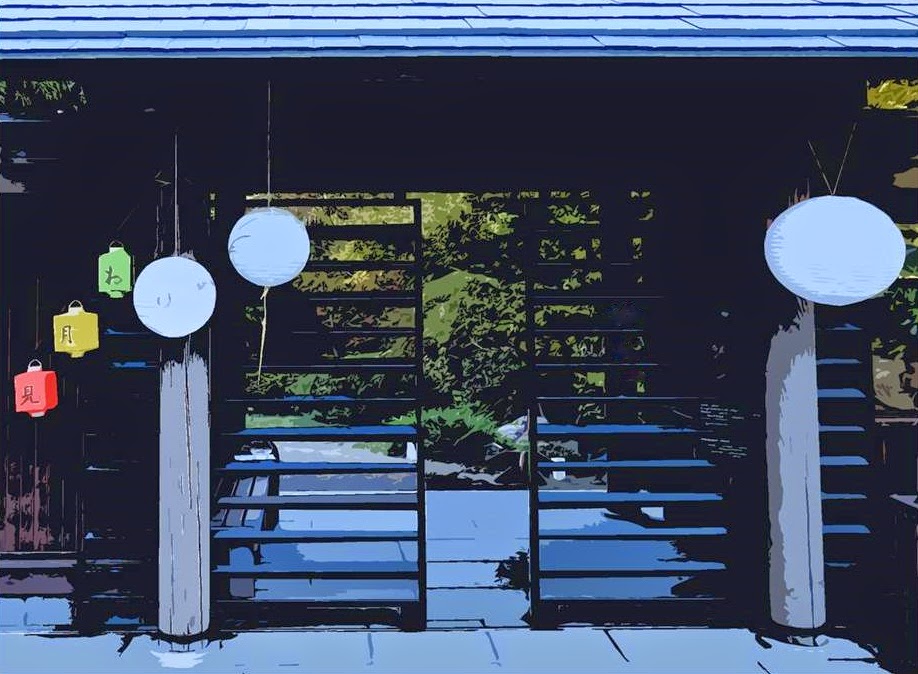by aleks
 |
| SJG • 9/6/14 - Lantern at Laceleaf maple; foto by Nat Suyenaga |
We had our usual attractions: tea ceremonies in the Shoseian Teahouse, Japanese music, butoh dance, haiku poetry readings and contest, and the Seattle Astronomical Society members ready with strong telescopes for people to view the rising moon in the mountain area of the Garden.
The moon DID appear in the full glory in the trees above the entrance gate. Luminaries on the paths, lanterns on the trees and, at dusk, candle-filled boats launched on the pond completed the utterly magical night. It is one of the Garden's celebration I try never miss - it's so very special and one of the kind.
 |
| SJG • 9/6/14 - WPA bridge area at Moon Viewing; foto by Nat Suyenaga |
 |
| SJG • 9/6/14 - butoh at moon viewing |
 |
| SJG • 9/6/14 - the moon DID appear |
 |
| SJG • 9/6/14 - Haiku writing station at Emperor's Gate |
• • • • •
• Noh in the Garden - Thursday, September 25th, 6:30 pm. Tickets on sale now (206-684-4725), limited to 100; some chairs in the orchard will be provided, but blankets and tatami mat welcome; in the event of rain the performance will be shifted to nearby Montlake Community Center - noh-goers will be notified (email) by noon of the day of the performance.
What is "NOH"? Noh is the oldest classical dance-dramas in Japan. It was developed in the 14th century from religious sources and folk myths. It is a combination of drama, music, and dance (mai). Noh is also one of the five major forms of traditional Japanese theater.
After 1374, Noh was patronized by the warrior class, whereas Kabuki (traditional theater) and Bunraku (classical puppetry) developed later for the common people. More here...
• Noh in the Act Theater (700 Union Street), September 26, Fri, 7pm, Sept. 27, Sat, 2 pm & 7pm, Sept. 28, Sun 2pm: The Beauty of Noh, Tomoe and Yoshinaka (for tickets go to the link below):
'The Beauty of Noh' will, for the first time, present a double-bill performance featuring Noh, the traditional dance-drama of Japan, alongside a modern Noh-inspired opera based on the same story.
The Noh opera 'Tomoe', based on the 'Tales of the Heike', is a love story about a woman, the famous 12th-century samurai warrior Tomoe Gozen, who is not allowed to die on the battlefield with her master, Yoshinaka.
The traditional Noh play 'Tomoe' will be performed by Munenori Takeda, one of Japan's most talented Noh masters, and the Takeda Noh Troupe. The Fisher Ensemble and Munenori Takeda will then perform 'YOSHINAKA', a modern opera based on the story of 'Tomoe' written by Seattle-based composer Garrett Fisher.
• • • • •
Attention up-coming (for the guides only): Do not miss Robert Pacht's informative and stimulating presentation Thursday, September 18: What lives in the pond at SJG? An overview of the aquatic ecology of our little pond. Robert writes: "Who lives in our pond, where did they come from and how do they thrive? An interactive discussion based on observations by Unit 86 docents, garden employees, visitors and myself. Our visitors are quite interested in this topic in my experience, and my philosophy on guiding is it's always about them and not about us. The more we have in our tool kits the more rewarding we can make our tours for our customers. I have not done and do not plan on doing any sampling so bring your observations with you as many of you have seen things that I have not."
 |
| SJG • 9/6/14 - Moon Viewing, Entry Gate; by Nat Suyenaga |

No comments:
Post a Comment
Note: Only a member of this blog may post a comment.